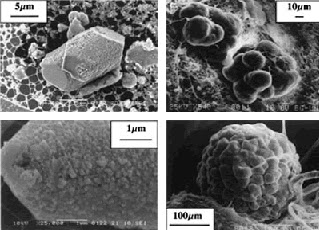The Pineal Gland: Crystal Transducer
The PINEAL GLAND is located within the human brain though its full potential is only beginning to be realized by modern scientists.
The pineal gland was the last endocrine gland to have its function discovered. Its location deep in the brain seemed to indicate its importance. This combination led to its being a "mystery" gland with myth, superstition and even metaphysical theories surrounding its perceived function.
Rene Descartes called the pineal gland the "seat of the soul", believing it is unique in the anatomy of the human brain in being a structure not duplicated on the right and left sides. This observation is not true, however; under a microscope one finds the pineal gland is divided into two fine hemispheres.
The pineal gland is occasionally associated with the sixth chakra (also called Ajna or the third eye chakra in yoga). It is believed by some to be a dormant organ that can be awakened to enable "telepathic" communication. It is already known to release various chemicals into our body, including a derivative of the feel good chemical serotonin, called melatonin. This hormone affects the modulation of our waking and sleeping patterns, but also affects our sex drive according to the seasons. Though scientists still admit that they still don't yet have a complete picture of the pineal gland's functions.
It is already known to release various chemicals into our body, including a derivative of the feel good chemical serotonin, called melatonin. This hormone affects the modulation of our waking and sleeping patterns, but also affects our sex drive according to the seasons. Though scientists still admit that they still don't yet have a complete picture of the pineal gland's functions.
It is located in the hidden center of the brain. It is pine cone shaped and no bigger than a raisin. Incredibly, it is actually bioluminescent, so glows within the darkness of the brain as if lit by a tiny light bulb, and has also been found to be sensitive to light. Interestingly enough, the anatomy of the gland actually consists of a
♦ Lens
♦ Cornea
♦ Retina
The pineal gland was the last endocrine gland to have its function discovered. Its location deep in the brain seemed to indicate its importance. This combination led to its being a "mystery" gland with myth, superstition and even metaphysical theories surrounding its perceived function.
Rene Descartes called the pineal gland the "seat of the soul", believing it is unique in the anatomy of the human brain in being a structure not duplicated on the right and left sides. This observation is not true, however; under a microscope one finds the pineal gland is divided into two fine hemispheres.
The pineal gland is occasionally associated with the sixth chakra (also called Ajna or the third eye chakra in yoga). It is believed by some to be a dormant organ that can be awakened to enable "telepathic" communication.
 It is already known to release various chemicals into our body, including a derivative of the feel good chemical serotonin, called melatonin. This hormone affects the modulation of our waking and sleeping patterns, but also affects our sex drive according to the seasons. Though scientists still admit that they still don't yet have a complete picture of the pineal gland's functions.
It is already known to release various chemicals into our body, including a derivative of the feel good chemical serotonin, called melatonin. This hormone affects the modulation of our waking and sleeping patterns, but also affects our sex drive according to the seasons. Though scientists still admit that they still don't yet have a complete picture of the pineal gland's functions. It is located in the hidden center of the brain. It is pine cone shaped and no bigger than a raisin. Incredibly, it is actually bioluminescent, so glows within the darkness of the brain as if lit by a tiny light bulb, and has also been found to be sensitive to light. Interestingly enough, the anatomy of the gland actually consists of a
♦ Lens
♦ Cornea
♦ Retina
Just like our eyeballs. Also, according to scientist Dr Grahame Blackwell, a large number of small crystals have been found in the gland called calcite micro-crystals. They bear a striking resemblance to the calcite crystals in the inner ear, that have been shown to exhibit the qualities of an electric field known as piezoelectricity. If the pineal gland crystals exhibit the same qualities, then this would provide a means whereby an external electromagnetic field might directly influence the brain.
At close magnification the Calcite Micro-Crystals are visible on the actual gland
Therefore, it is probably not surprising why over centuries of human history, esoteric groups consider the pineal gland (or All Seeing Eye) to be our built-in wireless transmitter, enabling us to connect to higher frequencies and spiritual worlds.
You can see representations of this pine shaped gland, in the form of a pine cone, across Europe and Egypt. The Vatican built the court of the pine cone, which is adorned with a large stone pine cone in front of it's entrance. It is also found on the staff of the Pope, and the Egyptian god Osiris.
Therefore, it is probably not surprising why over centuries of human history, esoteric groups consider the pineal gland (or All Seeing Eye) to be our built-in wireless transmitter, enabling us to connect to higher frequencies and spiritual worlds.
You can see representations of this pine shaped gland, in the form of a pine cone, across Europe and Egypt. The Vatican built the court of the pine cone, which is adorned with a large stone pine cone in front of it's entrance. It is also found on the staff of the Pope, and the Egyptian god Osiris.
The all seeing eye is also known to the Freemasons and other esoteric groups as the eye of providence. It can be found carved into medieval churches all over Europe. It can be seen above the French Declaration of Human Rights in a 1789 painting. It is also clearly illustrated on the back of the $1 dollar bill, floating above an Egyptian pyramid. An exact example of masonic symbology. Many believe that little attention has been given to pineal gland symbology in our society, because people with power do not wish to share its secrets with the general public.
Hopefully the examples in this chapter (Evidence & Belief) will help cement a stronger belief in the power of the universe. You will find that knowing that there is evidence of something's existence, helps you to believe that it is real. Remember, you need to believe in the universal law of attraction in order to make it work for you. Belief is an essential ingredient...
Hopefully the examples in this chapter (Evidence & Belief) will help cement a stronger belief in the power of the universe. You will find that knowing that there is evidence of something's existence, helps you to believe that it is real. Remember, you need to believe in the universal law of attraction in order to make it work for you. Belief is an essential ingredient...
New Crystal in the Pineal Gland:
Characterization and Potential Role in Electromechano-Transduction
Baconnier Simon(1), Lang Sidney B. (2), De Seze Rene(3)
(1) DRC, Toxicologie Expérimentale, INERIS, 60550 Verneuil-en-Halatte, France. E-mail : simon.baconnieretudiant@ineris.fr
(2)Department of Chemical Engineering, Ben-Gurion University of the Negev, 84105 Beer Sheva, Israel. E-mail :lang@bgumail.bgu.ac.il
(3) As (1) above, but E-mail : Rene.De-Seze@ineris.fr
Characterization and Potential Role in Electromechano-Transduction
Baconnier Simon(1), Lang Sidney B. (2), De Seze Rene(3)
(1) DRC, Toxicologie Expérimentale, INERIS, 60550 Verneuil-en-Halatte, France. E-mail : simon.baconnieretudiant@ineris.fr
(2)Department of Chemical Engineering, Ben-Gurion University of the Negev, 84105 Beer Sheva, Israel. E-mail :lang@bgumail.bgu.ac.il
(3) As (1) above, but E-mail : Rene.De-Seze@ineris.fr
ABSTRACT
The pineal gland is a neuroendocrine transducer secreting melatonin, responsible for the physiological circadian rhythm control. A new form of biomineralization has been studied in the human pineal gland. It consists of small crystals that are less than 20 μm in length.
These crystals could be responsible for an electromechanical biological transduction mechanism in the pineal gland due to their structure and piezoelectric properties. Using scanning electron microscopy (SEM) and energy dispersive spectroscopy (EDS), we identified crystals morphology and showed that they only contain calcium, carbon and oxygen elements. Furthermore, the selected-area electron diffraction (SAED) and near-infrared Raman spectroscopy established that the crystals are calcite.
We will now focus on the physiological effect of microcrystals in pinealocyte cell culture under Radio-Frequency Electromagnetic-Fields (RF-EMF).
 INTRODUCTION
INTRODUCTION Because of the fast development of mobile telecommunication, the interaction of Electromagnetic Fields (EMF) with biological environment becomes a public health concern. Although the action of non-ionizing radiation on biology is still unclear, several hypotheses of interaction have been suggested: hot spot phenomena, ADN/RF-EMF interaction, EMF effect on cellular development (oncology) [1-3]. But no convincing study brings to the conclusion of an effective risk of RF-EMF for health.
The pineal gland converts a neural signal into an endocrine output. The most important hormone it secretes is melatonin the main role of which is to control the physiological circadian rhythm [4].
Two biomineralization forms can be observed in the pineal gland. Concretions so called "brain sand", a polycrystalline complex of few millimeters long, and microcrystals the length of which does not exceed 20 micrometers. While concretions have been extensively studied [5-9] no study has been published on the microcrystals.
In this article the microcrystals were analyzed with different biophysical techniques. Their physicochemical properties and particularly piezoelectricity would give them an active role in a potential mechanism of electromechanotransduction in the pineal body. We are currently planning a study on the effects of Global System for Mobile (GSM) waves on these microcrystals in cellular culture and their influence on the pineal body physiology.
MATERIALS AND METHODS
The microcrystals were isolated from the pineal bodies using a procedure developed by Weiner and Price [10].
Small pieces of the pineal body (about 10 mg) were placed in a micro-centrifuge tube containing 1.5 ml of 2.5% sodium hypochlorite (diluted commercial bleach) and sonicated for 20 minutes. After allowing the sample to settle for 1 minute, the supernatant liquid was transferred to a second micro-centrifuge tube and centrifuged at approximately 9000 g for 1 minute. The pellet containing the solids was immediately washed twice with 95% ethanol and then resuspended in approximately 50 μl of 100% ethanol. It should be emphasized that, at no point, did any of the samples come into contact with solutions containing calcium ions.
SEM samples were collected on transmission electron microscopy grids and analyzed with a JEOL JSM 5600 SEM. Microanalysis studies were performed with a NORAN EDS Analyzing System. Because the microcrystals were initially too thick for High Resolution Transmission Electron Microscopy 2 (HRTEM) observation, they were first crushed between two glass slides. They were then studied with a JEOL-2010 transmission electron microscope equipped with an analytical ISIS system for energy dispersive X-ray spectroscopy (EDS).
Near infrared Raman spectra of isolated crystals and pure calcite were obtained with a Bruker IFS 66 FTIR spectrometer equipped with an FRA 106 Raman module and a Ramanscope microscope. Measurements were made with a 40X objective (spot size ~25 μm). The spectral resolution was 2 cm-1. The samples were excited at 1064 nm using a diode-pumped Nd:YAG laser at about 5 mW power. Second Harmonic Generation (SHG) studies were made with a Nd-YAG laser which produced radiation at 1064 nm and the detected SHG was at 532 nm.
The microcrystals were isolated from the pineal bodies using a procedure developed by Weiner and Price [10].
Small pieces of the pineal body (about 10 mg) were placed in a micro-centrifuge tube containing 1.5 ml of 2.5% sodium hypochlorite (diluted commercial bleach) and sonicated for 20 minutes. After allowing the sample to settle for 1 minute, the supernatant liquid was transferred to a second micro-centrifuge tube and centrifuged at approximately 9000 g for 1 minute. The pellet containing the solids was immediately washed twice with 95% ethanol and then resuspended in approximately 50 μl of 100% ethanol. It should be emphasized that, at no point, did any of the samples come into contact with solutions containing calcium ions.
SEM samples were collected on transmission electron microscopy grids and analyzed with a JEOL JSM 5600 SEM. Microanalysis studies were performed with a NORAN EDS Analyzing System. Because the microcrystals were initially too thick for High Resolution Transmission Electron Microscopy 2 (HRTEM) observation, they were first crushed between two glass slides. They were then studied with a JEOL-2010 transmission electron microscope equipped with an analytical ISIS system for energy dispersive X-ray spectroscopy (EDS).
Near infrared Raman spectra of isolated crystals and pure calcite were obtained with a Bruker IFS 66 FTIR spectrometer equipped with an FRA 106 Raman module and a Ramanscope microscope. Measurements were made with a 40X objective (spot size ~25 μm). The spectral resolution was 2 cm-1. The samples were excited at 1064 nm using a diode-pumped Nd:YAG laser at about 5 mW power. Second Harmonic Generation (SHG) studies were made with a Nd-YAG laser which produced radiation at 1064 nm and the detected SHG was at 532 nm.
RESULTS AND DISCUSSION
The SEM studies of single microcrystals permitted high-quality morphological analysis. The most common morphology was a very rough cylindrical body with sharp extremities (Fig. 1) that comprised about 95% of the samples observed. The crystal size varied from 1 to about 20 μm. The EDS analyzer coupled to the SEM identified calcium, carbon and oxygen to be the principal elements. Among biominerals containing those atoms, only calcium carbonate and calcium oxalate are potential candidates. The electron diffraction patterns taken from the particles were indexed in terms of a hexagonal unit cell.
Near IR Raman spectra were measured on both the microcrystals and on pure calcite powder. The agreement of the peaks was excellent (Fig. 2), confirming the identification of the crystals as calcite (calcium carbonate). We were unable to detect SHG neither in pure hydroxyapatite powder nor in the large pineal concretions. The similarity of the intensity of the SHG in pure calcite to that observed in earlier work on pineal tissue samples [11] and the absence of SHG in the large concretions let us think the calcite microcrystals would be the source of the SHG in the previous observation.
The pineal microcrystals appear as a stack of thin rhombohedrons with their flat faces normal to the long axis of the crystal (Fig. 3). These complex structures can be classified using the texture point group nomenclature of Shubnikov et al. [12]. The texture may be noncentrosymmetric because of the structural organization of the sub-unit, even though the single crystals do have a center of symmetry. This symmetry breaking would allow both SHG and piezoelectricity.
Calcite in otoconia, microcrystals found in the inner-ear otolith, has been shown to exhibit piezoelectricity [13, 14].
These crystals have a structure similar to that of the pineal microcrystals.
By that very fact the piezoelectric property of the crystals would allow them to interact with the electrical component of electromagnetic fields. A simplified formula applied to those crystals (f = v/2d) lets us think that these crystals could be sensitive to RF-EMF in the range of 500MHz to 2.5GHz depending on there size. This range contains portable wireless frequencies, GSM (872-960MHz), DCS (1710-1875MHz), UMTS (1900-1920MHz, 2010-2025MHz), or BlueTooth (2400-2483,5MHz). Piezoelectric determination of minute grain requires developing new methods based on either MEMS Precision Instruments microtweezers or direct correlation between electro-optic and piezoelectric properties in crystal with optical microscopy.
We introduce a novel approach of the biophysical effects of weak microwave radiation.
CONCLUSION AND PERSPECTIVES
We report here the presence of a new form of mineral deposits in the pineal gland. The calcite microcrystals would have piezoelectric properties with excitability in the frequency range of mobile communications. Their interaction with GSM waves could constitute a new mechanism of electromecano-transduction on the pinealocyte membrane, influencing by the fact the melatonin production.
The RF-EMF electrical component interaction with the crystals could induce a morphological modification of the crystals, a vibration depending on the EMF frequency. This morphological change, even tiny, could involve a modification of their cellular environment, by a localized modification of the cellular membrane of related cells.
The membrane changes could alter the adrenergic suggested and/or calcium channel function.
A similar mechanism of magneto-transduction was revealed by Kirschvink in connection with magnetite crystals of the brain and their interaction with the magnetic component of RF-EMF [15].
Pinealocyte can "communicate" through their gap junction [16, 17]. The deformation caused by the crystal vibrations could thus by simple activation of one or two pinealocytes, activate a whole area of pineal cells and thereby act on the pineal physiology.
The scientific project to be developed is to determine the influence of RF-EMF GSM on pinealocyte and pineal gland physiology through the electromechano-transduction produce by the pineal microcrystals. Using ELISA tests and Laser Scanning Confocal Microscopy we are going to study the evolution in melatonin production and variation in cell calcium flux in primary pineal cell culture.
From harvest Insight @ http://www.harvestinsight.webs.com/
Source: nexusilluminati.blogspot.ro - See more at: http://www.riseearth.com/2013/07/the-pineal-gland-crystal-transducer.html#sthash.F59Ikzxu.dpuf








